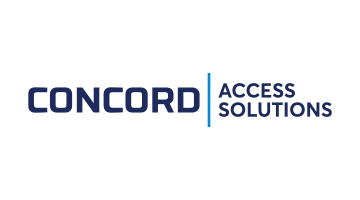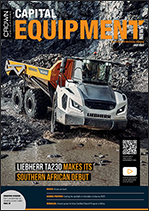 Liebherr TA230 makes its southern African debut
Liebherr TA230 makes its southern African debut
On the cover: Liebherr-Africa has launched the Liebherr TA 230 Litronic articulated dump truck (ADT) in southern Africa. The new ADT – which plugs the gap in the company’s earthmoving product range – made its local debut at an Open Day held on 24 June 2022.
Following its global unveiling last year, the Liebherr TA 230 articulated hauler is finally available for the local market. Speaking at the Open Day, Dieter Schmid, MD of Liebherr-Africa, said the new ADT closes a crucial gap in the company’s wide earthmoving equipment range.
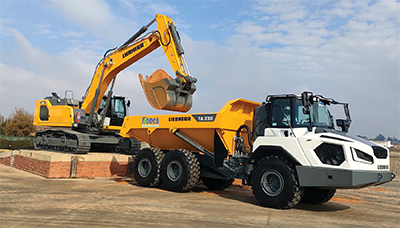 “With the addition of the TA 230 Litronic, we have become a full-liner in the earthmoving area. The ADT is the last piece of the puzzle, making us a one-stop shop for all our customers’ earthmoving equipment needs,” said Schmid.
“With the addition of the TA 230 Litronic, we have become a full-liner in the earthmoving area. The ADT is the last piece of the puzzle, making us a one-stop shop for all our customers’ earthmoving equipment needs,” said Schmid.
Tendayi Kudumba, General Manager: Earthmoving at Liebherr-Africa, says the new 30-tonne (t) class ADT is ideally suited for quarrying, coal mining and large infrastructure projects. Thanks to its optimal structure gauge, the TA 230 can also be deployed in special applications such as tunnel construction and underground mining.
In fact, the very first TA 230 Litronic in Africa, which has been delivered to Zimbabwe-based mining contractor Orca Group, will be deployed in an underground application at the Freda Rebecca Gold Mine in Bindura, Zimbabwe, hauling ore from the underground tunnels to the overland crushers. This, says Gordon Watson, MD of Orca Group, will be a true test for the new ADT.
Buses are back
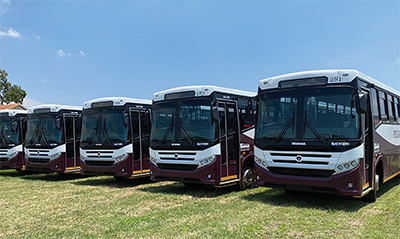 It’s been a tough two years for bus operators. Covid-19 pandemic regulations mandated operators to run with a 50% passenger capacity which Kabelo Mphahlele, chief operating officer of Ipelegeng Transport Trust, says was an enormous challenge for his business. “Following a 50% passenger load capacity doesn’t support the business model. Fuel and driver costs remained at 100% but we could only earn a maximum of half of our normal revenue.”
It’s been a tough two years for bus operators. Covid-19 pandemic regulations mandated operators to run with a 50% passenger capacity which Kabelo Mphahlele, chief operating officer of Ipelegeng Transport Trust, says was an enormous challenge for his business. “Following a 50% passenger load capacity doesn’t support the business model. Fuel and driver costs remained at 100% but we could only earn a maximum of half of our normal revenue.”
Recent threats of violence emanating from a competing transport sector are also threatening to derail the bus industry’s recovery efforts.
“The cake is now smaller,” says Mphahlele. “Passengers should be allowed to choose where they want to spend their money. However, our competitor wants to keep their passenger loads at levels that reflect past figures. These are no longer sustainable.”
Mphahlele cites Ipelegeng company data that shows an influx of people travelling on their buses every Monday and only returning again on a Friday.
“This suggests they are staying closer to work during the week and commuting home at the weekends,” says Mphahlele. It is a changing trend that is affecting the whole commuter industry.
“The government needs to step up and protect us. We have lost a bus through violence. It was shot at and set alight,” says Mphahlele. Despite these difficult challenges, Ipelegeng is continuing to serve its passengers and a new customer-centric partnership with Scania promises to take the company to new heights.
Casting the spotlight on innovation at bauma 2022
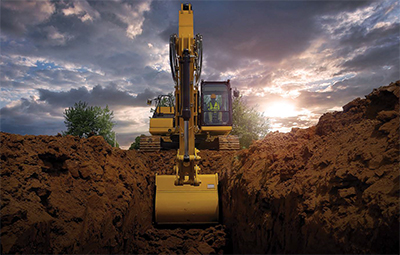 Judging from pronouncements made by some of the leading capital equipment exhibitors thus far, bauma 2022 will shine the spotlight on innovation, with trends such as automation, electromobility and digitalisation set to take centre stage.
Judging from pronouncements made by some of the leading capital equipment exhibitors thus far, bauma 2022 will shine the spotlight on innovation, with trends such as automation, electromobility and digitalisation set to take centre stage.
Initially scheduled for April, bauma 2022 – the biggest trade show of its nature in the world – returns later this year from 24 to 30 October, following the Covid-19 influenced postponement. The impact of the pandemic on the events industry has been significant and bauma was no exception.
However, the show returns at a time when the global equipment market is seemingly enjoying a good run. According to the KHL Group’s Yellow Table, which compiles and ranks the sales results for the world’s biggest equipment manufacturers, the construction equipment sales for the world’s top 50 original equipment manufacturers (OEMs) have hit record levels. In the 2022 Yellow Table, sales were up 20,8% to take the table to its highest ever total of US$232,7-billion as most markets in the world saw growth with industry bounced-back from the impact of the Covid-19 pandemic.
In light of evolving customer behaviour, which has accelerated due to the pandemic, this year’s event will however miss some of the big names in the industry, with companies such as Volvo Construction Equipment, JLG and JCB not exhibiting at the show.
Last year, Volvo Construction Equipment announced a new marketing approach aimed at even closer engagement with its customers. Carl Slotte, head of Region Europe at Volvo CE, says that while physical interaction remains important, the company is beginning to see significant changes in the way customers want to engage with the OEM, both digitally and face-to-face. This is driven by technological possibilities of doing business more efficiently and the increasing need to do business more sustainably.
Interest grows for Volvo Certified Rebuild Program in Africa
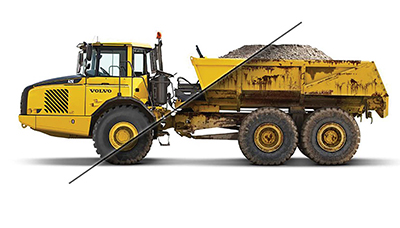 By refurbishing machines to the standard of new ones, the Volvo Certified Rebuild Program is helping to tackle issues of environmental impact, cost and machine supply, with quality and uptime guaranteed.
By refurbishing machines to the standard of new ones, the Volvo Certified Rebuild Program is helping to tackle issues of environmental impact, cost and machine supply, with quality and uptime guaranteed.
Launched in Africa in 2016, the Volvo Certified Rebuild Program has received renewed interest of late for its sustainability and offer of a like-new machine with a short lead time and at a lower cost. The programme is especially attractive in the mining and quarrying sectors, where machinery rapidly clocks up high production hours.
Once a machine has reached a certain number of hours on the clock, the dealer will carry out a thorough inspection and may recommend the replacement of one or more parts to prolong its service life.
Where replacement parts are needed, the customer can choose new parts or the cheaper and more sustainable option of factory remanufactured components from Volvo Reman. Where multiple parts should be replaced, Volvo Construction Equipment (Volvo CE) offers three packages through the Volvo Certified Rebuild Program: Complete Rebuild, Powertrain Rebuild, or Hydraulics Rebuild. The dealer inspection report will define what kind of rebuild is needed for that specific machine.
The benefits and applications of the self-erecting tower crane
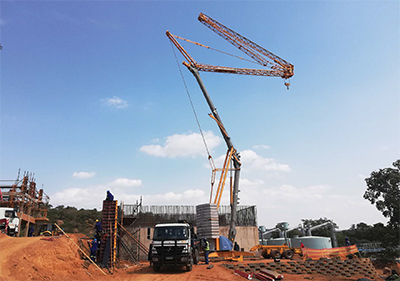 The self-erecting or ‘bottom-slewing’ crane offers advantages including reduced siting costs, ease of mobility, a small on-site footprint and excellent reach and lifting capacity. For this feature, we approached two local distributors for their take on the applications and benefits of self-erecting tower cranes, as well as the ranges available in South Africa.
The self-erecting or ‘bottom-slewing’ crane offers advantages including reduced siting costs, ease of mobility, a small on-site footprint and excellent reach and lifting capacity. For this feature, we approached two local distributors for their take on the applications and benefits of self-erecting tower cranes, as well as the ranges available in South Africa.
MMS Mobile Cranes sales manager Jared Terry describes the self-erecting or ‘bottom-slewing’ crane as a specific type of tower crane that does not require a mobile crane to be erected. He says this type of crane uses its own hydraulic cylinders to erect itself and is used in applications such as building, structural steel installation and the pouring of concrete on smaller construction sites.
To Brenden Crous, MD of Crane and Hoist Equipment SA, the self-erecting tower crane is a compact and easy to erect crane which can be transported to site behind a truck or on a low bed.
“Its compact design allows the crane to be erected on multiple positions on construction sites easily, without preparation of large concrete bases.” He says these cranes are erected and dismantled via remote control. “This process is controlled automatically by hydraulic cylinders. The hydraulic system unfolds the mast and jib sections into the final operating position of the crane.”
According to Terry, self-erecting cranes are well accepted in the South African market and clients often prefer self-erecting cranes due to the minimal establishment costs and the convenience of being able to move the crane on site with ease.
Backhoe loaders: centre-mount or side-shift?
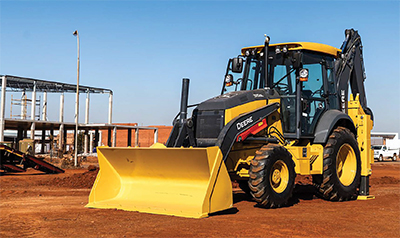 This feature discusses the differences between centre-mount and side-shift backhoe loaders and casts the spotlight on their respective advantages and applications. We explore the metrics to consider when choosing between the two and highlight some models available in the South African market.
This feature discusses the differences between centre-mount and side-shift backhoe loaders and casts the spotlight on their respective advantages and applications. We explore the metrics to consider when choosing between the two and highlight some models available in the South African market.
Discussing the differences between centre-mount and side-shift backhoe loaders, John Deere Construction & Forestry sales manager covering Africa and Middle East, Griffiths Makgate says that, on centre-mount backhoe loaders, the backhoe is mounted to the centre of the machine with fabricated stabilisers that extend outwards, making it the ideal machine for general construction work where space is not a constraint.
“The machine works in open fields, road building, on farms and in any application that can accommodate the outward stabilisers,” he says. John Deere’s 310 L model backhoe loader is equipped with standard length stabilisers.
With side-shift backhoe loaders such as John Deere’s 315 SL, the operator can easily unlock and shift the backhoe along the H-frame using a single combination in-cab switch located on the main control panel.
This, says Makgate, eliminates the risk of damaging streets, parking lots or other terrain when manually shifting the backhoe with the rear bucket. He says that, with two hydraulic cylinders to shift the backhoe, the design eliminates the need for a chain-drive or pulley system.
Bronze wear pads are used on the H-frame to reduce friction and improve the durability and wear life of the slide rail. This feature enables offset digging for improved visibility to the trench and the powered side-shift option allows operators to take full advantage of the 315 SL’s narrow footprint with vertical stabilisers.
Don’t compromise on vibrating screen health
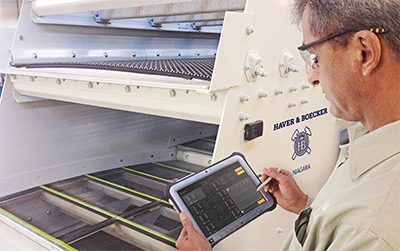 Vibrating screens work at the heart of an operation; every tonne of material must be screened at least once before it is loaded into a truck for sale. And just like the human heart, they need to be kept strong and healthy to do their job well.
Vibrating screens work at the heart of an operation; every tonne of material must be screened at least once before it is loaded into a truck for sale. And just like the human heart, they need to be kept strong and healthy to do their job well.
Maintenance crews have a lot to take care of. From vibrating screens and crushers to conveyors and load trucks, the list is a long one. It’s tough to be an expert on every piece of equipment. By partnering with a technical vibrating screen OEM that also specialises in equipment monitoring, operations can rely on a team that not only manufactures the equipment, but offers comprehensive diagnostic tools, product-specific knowledge and years of engineering experience. The result can be peace of mind, minimised downtime through faster problem solving and lower repair costs down the line.
There’s a wide range of OEMs to choose from. While many have engineered reputable screening equipment, it’s important to consider the services they offer to take care of that equipment for the long run. One that has dedicated research and development focused on diagnostic tools, for example, will be that much further ahead in keeping that heart of the operation healthy.
Vibration analysis is one such tool dedicated to measuring the health of vibrating screens. These systems measure and transmit real-time vibration data such as acceleration, orbit, deviations and more. While the machine is in operation, the data is transmitted via sensors that are placed at dedicated locations on the screen body. The information is recorded to software in a phone, tablet or computer, or to a cloud service where it can be viewed from multiple devices.





